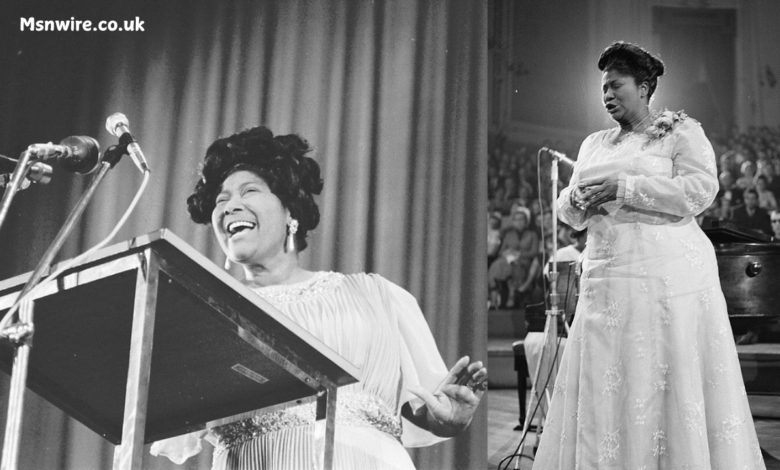Sigmond Galloway: The Jazzman Behind the Queen of Gospel

Sigmond Galloway, born on May 18, 1922, in Wetumpka, Alabama, is etched in the annals of jazz and gospel history. Known for his remarkable voice and artistic contributions, Galloway was also the second husband of the legendary gospel singer Mahalia Jackson. His life and career blend musical brilliance, personal struggles, and a complex legacy that continues to intrigue music enthusiasts. In this article, we will explore the life, career, and lasting impact of Sigmond Galloway.
Early Life and Musical Roots
As he was formally known, Minters Sigmond Galloway grew up in the Southern rhythms of Alabama, a state renowned for its extensive musical heritage. From an early age, Galloway showed a penchant for music, often drawn to the soulful melodies of gospel and blues that resonated through his community. These early influences would later shape his unique approach to jazz, which he embraced fervently.
While his personal life during his formative years remains mainly undocumented, Alabama’s cultural environment played a pivotal role in cultivating his passion for music. He eventually relocated to Gary, Indiana, which proved instrumental in his career. Gary’s vibrant African-American community and dynamic music scene offered Galloway a platform to hone his craft and establish himself as a notable figure in the jazz world.
Military Service and Its Influence
During World War II, Galloway served in the U.S. Army, an experience that expanded his worldview and exposed him to diverse musical traditions. This service period interrupted his budding musical journey but enriched his artistic perspective. Military life’s discipline, camaraderie, and exposure to new cultures and rhythms profoundly influenced his approach to music.
Upon his return to civilian life, Galloway channelled these experiences into his music, infusing his performances with a depth and resonance that captivated audiences. His baritone voice, characterized by its smooth transitions and emotional intensity, became his signature.
Rise in the Jazz Scene
Sigmond Galloway’s move to Gary marked a turning point in his career. Initially working in construction to make ends meet, he eventually transitioned to music full-time. This decision proved fruitful, as he became a celebrated performer in local jazz circles. His ability to blend jazz’s improvisational elements with gospel’s spiritual undertones set him apart from his contemporaries.
Performing in clubs and at community events, Galloway’s music began to attract attention. His style, a seamless fusion of Southern blues and sophisticated jazz, earned him recognition among peers and audiences. Despite the challenges of asserting himself in a competitive profession, Galloway’s determination and talent ensured his place in the local jazz scene.
Marriage to Mahalia Jackson
In 1964, Sigmond Galloway married Mahalia Jackson, the Queen of Gospel. Their union was both a personal and professional milestone. The two met through mutual acquaintances and bonded over their passion for music. Their wedding, held in Jackson’s living room, surprised many and symbolized the convergence of two significant musical forces.
However, their marriage was not without its challenges. Jackson’s demanding career and health issues strained their relationship. Galloway’s attempts to manage her professional affairs, coupled with his infidelities, led to frequent conflicts. In 1967, after three tumultuous years, the couple divorced. The separation was marked by publicized disputes, with Jackson successfully defending her assets in court.
Life After Divorce
Following his divorce from Mahalia Jackson, Sigmond Galloway retreated from the public eye. While he continued to perform, his career never regained its former prominence. He chose a quieter existence, focusing on local performances and avoiding the limelight.
Despite his reduced visibility, Galloway’s contributions to jazz remained significant. His performances were characterized by emotional depth and technical finesse, resonating with audiences even as his fame waned.
Musical Legacy
Sigmond Galloway’s impact on jazz, though often overshadowed by his association with Mahalia Jackson, is undeniable. His ability to bridge the gap between gospel and jazz created a unique sound that left an indelible mark on both genres. Galloway’s performances, marked by their soulful depth and innovative improvisations, continue to inspire musicians and listeners alike.
Sadly, recordings of Galloway’s work are scarce, adding an air of mystery to his legacy. Efforts to uncover and preserve his musical contributions are ongoing, offering hope that future generations will fully appreciate his artistry.
Death and Final Years
Sigmond Galloway passed away on May 18, 1972, in Gary, Indiana, at 50. His death, which occurred just months after Mahalia Jackson’s passing, marked the end of a life rich in music but fraught with personal struggles. He was laid to rest in Fern Oaks Cemetery in Griffith, Indiana.
Legacy Beyond Music
Beyond his contributions to jazz, Sigmond Galloway’s life offers valuable insights into his time’s cultural and social dynamics. His journey from Alabama to Indiana, his experiences as a musician and military serviceman, and his tumultuous marriage to Mahalia Jackson reflect broader themes of resilience, creativity, and the complexities of human relationships.
Today, Galloway’s story reminds us of the enduring power of music to transcend personal challenges and connect with audiences on a profound level.
Conclusion
Sigmond Galloway was more than just the husband of Mahalia Jackson; he was a talented jazz musician whose voice and artistry enriched the musical landscape of his era. While his life was cut short, his legacy lives on through the memories of those who heard him perform and the ongoing efforts to rediscover his contributions to jazz.



